RUDN neurosurgeons studied the immune response to multiple injuries
Polytrauma is multiple traumatic injuries of organs and tissues, for example, in car accidents or falls from a great height. Multiple lesions provoke a complex and dynamic immune response of the body. Often, against this background, a patient with polytrauma may develop infectious complications. Therefore, in the treatment of polytrauma , it is necessary to understand the features of the immune response in order to be able to take action in time.
“Polytrauma requires surgical treatment and intensive care in specialized multidisciplinary trauma centers. It is in this group of victims that the highest mortality and disability are observed. The pathophysiology and immunological aspects of polytrauma are systematically studied. However, the features of defense reactions in traumatic injuries have yet to be studied,” said Albert Sufianov, MD, Educational and Scientific Institute of Neurosurgery, RUDN University.
The medical study involved 188 patients with serious injuries. The control group included 210 trauma patients with minor injuries. Neurosurgeons examined blood samples before hospitalization, during hospitalization, every other day, three days, a week, and then every few days up to three months after hospitalization. Doctors tracked the level of T-lymphocytes — cells that recognize and destroy foreign antigens. The authors also looked at the level of some proteins associated with the immune response — cytokines, chemokines , immunoglobulins and circulating immune complexes.
Under the influence of polytrauma , the content of T-lymphocytes decreased. However, the content of other types of lymphocytes increased. The most pronounced effect became noticeable on the 30th day after discharge. Cytokine concentrations were highest on the day of injury and then gradually declined.
“As we continue to expand our knowledge of the immune response factors associated with polytrauma, we will be better prepared to develop new therapeutic strategies to treat this serious clinical and social problem,” said Albert Sufianov, MD, Director of Educational and Scientific Institute of Neurosurgery, RUDN University.
The results are published in Non-coding RNA Research.
Sergey Ivanov, a scholar from St. Petersburg, has been named the first winner of RUDN University’s International Prize for Scientific Achievements in Mathematics, worth 5 million rubles.
Products derived from microalgae represent a cutting-edge development in the field of bioeconomy. The potential of this biological resource was discussed at the international research seminar “Foundations for a Green Sustainable Energy”, part of the BRICS Network University’s thematic group on “Energy”. The event was organized by the Institute of Ecology at RUDN University.
Ambassadors of Russian education and science met at a conference in RUDN University to discuss how they can increase the visibility of Russian universities and research organizations in the world, and attract more international students in Russia.
